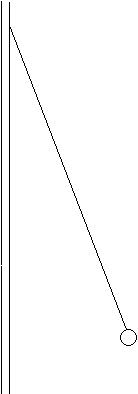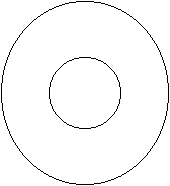| 1. (20 points) A 1.0-kg
piece of metal is taken from a furnace at a temperature of 9000C. It is dropped
into 4.0 kg of water at 10 0C. Assume no heat is lost to the surroundings. The
specific heat of the metal is 450 J/kg0C. The specific heat of water is 4186
J/kg0C. What is the total change in entropy of the system? |
| 1. Solution Outline: See the solution to problem #4 of real test 1 . Same problem. Different numbers. |
| 2. (20 points)
BALANCING GRAVITY AND ELECTRIC FIELDS. 4B SP12 REFERENCE: QUIZ
1, #82, 33, 35; QUIZ 2,
#30-UNIFORM ELECTRIC FIELD PERPENDICULAR TO INFINITE PLANE; In the
figure below, a small, nonconducting ball of mass m = 1.0x10-3 g and
positive charge q = 2.0x10-8 C hangs from an insulating
thread that makes an angle = 300 with a vertical, uniformly charged
nonconducting sheet. Assume the sheet is infinite. It extends far in all directions
within its plane. What is the surface charge density (in C/m2) of the sheet?
|
| 2. Solution
Outline: See example 23.4 horizontal tension=electric force: Tsin30 = qE vertical tension = vertical weight: Tcos30 = mg Divide these two equations to get: Solve for the density. |
| 3. ( 20 points) 4B
SP12 REFERENCE: SOLID INSULATING SPHERE QUIZ
2, #23, #54 A solid
sphere of radius R carries a volume charge density given by a function of r:
|
| 3.Solution: This
is a challenging problem. Before you attempt it, you should understand
completely how to do example 24.5 in the textbook. I could put a
problem like that example on the real test next Wednesday. Example 24.5 is
for a constant charge density. The sample test problem is when the charge density
is not constant. I will probably not put a problem with
non-constant charge density on the test. Still, I will outline the
solution for your information:
For r < R
For r > R, the system behaves like a point charge, so E will be proportional to r-2
|
| 4. ( 12 points) EXTRA
CREDIT 4B SP12
REFERENCE: POTENTIAL OF TWO CONCENTRIC SHELLS: QUIZ
3, #47 Two thin, conducting, spherical shells are shown below. The inner shell has a radius a = 15 cm and a charge 10 nC. The outer shell has a radius b = 40 cm and a charge of -5 nC. Note: 1 nC = 1x10-9C Find the potential as a function of r in the regions (a)( 4 points) b < r (b)( 4 points) a < r < b (c)( 4 points) r < a |
| Solution: Please
review page 774 of the textbook. This may help you on the real test and on
test #3 ! 4.(a) Outside for b < r, the system looks like a point charge. The charge enclosed by a Gaussian sphere of radius r > b is 10nC - 5nC = 5nc = 5x10-9C = Qout Thus, E = kQout/r2 and so V = kQout/r (b) You must integrate the electric field
in part (a) from infinity to r = 40 cm = 0.40 m. This yields kQout/0.40.
Then you must continue the integration of E from r = |





